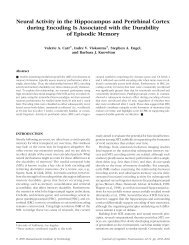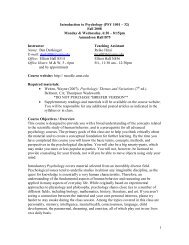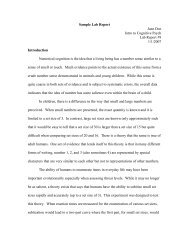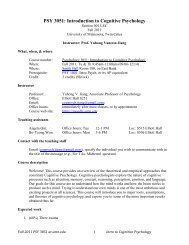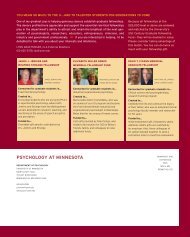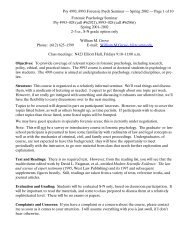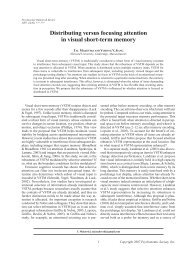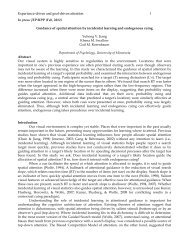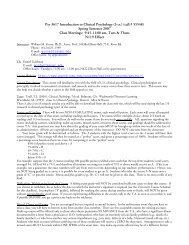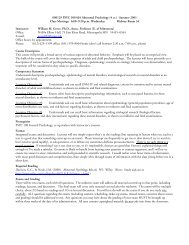The role of timing in the attentional boost effect - Attention, Memory ...
The role of timing in the attentional boost effect - Attention, Memory ...
The role of timing in the attentional boost effect - Attention, Memory ...
You also want an ePaper? Increase the reach of your titles
YUMPU automatically turns print PDFs into web optimized ePapers that Google loves.
Atten Percept Psychophys (2011) 73:389–404 391Jiang et al., 2002; Sekuler & Bennett, 2001). However,because previous research on <strong>the</strong> <strong>attentional</strong> <strong>boost</strong> <strong>effect</strong>has been restricted to paradigms <strong>in</strong> which <strong>the</strong> target andimage onset at <strong>the</strong> same time, <strong>the</strong> <strong>role</strong> <strong>of</strong> time <strong>in</strong> this <strong>effect</strong>has not been explored.Here, three experiments constra<strong>in</strong> <strong>attentional</strong> cu<strong>in</strong>g,re<strong>in</strong>forcement, and perceptual group<strong>in</strong>g hypo<strong>the</strong>ses bymanipulat<strong>in</strong>g <strong>the</strong> temporal relationship between <strong>the</strong> backgroundimages and <strong>the</strong> search stimuli. For <strong>the</strong>se experiments,participants first encoded a long series <strong>of</strong> brieflypresented images <strong>in</strong> a dual-task encod<strong>in</strong>g procedure.Dur<strong>in</strong>g image encod<strong>in</strong>g, participants were asked to monitora second stream <strong>of</strong> white and black squares that appeared <strong>in</strong><strong>the</strong> same location as <strong>the</strong> images. 1 <strong>The</strong> participants’ task wasto remember <strong>the</strong> background images for a memory test andto press <strong>the</strong> spacebar whenever a white square appeared.<strong>The</strong> <strong>tim<strong>in</strong>g</strong> <strong>of</strong> <strong>the</strong> onset <strong>of</strong> <strong>the</strong> squares relative to <strong>the</strong> onset<strong>of</strong> <strong>the</strong> images was manipulated. In some conditions <strong>the</strong>square temporally overlapped with a pre- or post- imagemask <strong>in</strong>stead <strong>of</strong> <strong>the</strong> image itself. To preview <strong>the</strong> results,temporal overlap, but not common onset, was necessary for<strong>the</strong> <strong>attentional</strong> <strong>boost</strong> to occur <strong>in</strong> <strong>the</strong>se experiments. Todeterm<strong>in</strong>e whe<strong>the</strong>r temporal overlap is sufficient for <strong>the</strong><strong>attentional</strong> <strong>boost</strong> <strong>effect</strong>, a f<strong>in</strong>al experiment manipulated <strong>the</strong>relevance <strong>of</strong> <strong>the</strong> background image to participants’ task.<strong>The</strong> outcome <strong>of</strong> this experiment suggested that <strong>the</strong><strong>attentional</strong> <strong>boost</strong> <strong>effect</strong> is modulated by attention to <strong>the</strong>background image.Experiment 1: does <strong>attentional</strong> cu<strong>in</strong>g accountfor enhanced image encod<strong>in</strong>g?1 In <strong>the</strong> present experiments, targets were always white squares anddistractors were always black squares. However, previous researchused a variety <strong>of</strong> targets and distractors types and has generalized <strong>the</strong><strong>effect</strong> to more demand<strong>in</strong>g detection tasks, such as when <strong>the</strong> target isdef<strong>in</strong>ed by <strong>the</strong> conjunction <strong>of</strong> color and letterform (Swallow & Jiang,2010).Perceptual enhancement as a consequence <strong>of</strong> <strong>attentional</strong>orient<strong>in</strong>g peaks approximately 100–200 ms after a cue(Egeth & Yantis, 1997; Nakayama & Mackeben, 1989;Olivers & Meeter, 2008). If targets cue attention to <strong>the</strong>background images, <strong>the</strong>n images presented 100 ms after <strong>the</strong>target should benefit as much if not more from this cu<strong>in</strong>gthan images presented at <strong>the</strong> same time as targets. This ideais supported by observations <strong>of</strong> lag-1 spar<strong>in</strong>g <strong>in</strong> <strong>the</strong><strong>attentional</strong> bl<strong>in</strong>k: When a short <strong>in</strong>terval separates twotargets <strong>in</strong> a rapid visual stream, <strong>the</strong> second target (T2) is<strong>of</strong>ten detected more accurately than <strong>the</strong> first target (T1),presumably because it falls <strong>in</strong> <strong>the</strong> peak <strong>of</strong> <strong>the</strong> orient<strong>in</strong>gresponse triggered by T1 (Potter, Staub, & O’Connor2002). Experiment 1 tested this <strong>attentional</strong> cu<strong>in</strong>g hypo<strong>the</strong>sisby present<strong>in</strong>g <strong>the</strong> images for 100 ms (with a 400-ms<strong>in</strong>ter-stimulus <strong>in</strong>terval dur<strong>in</strong>g which <strong>the</strong> image was masked)and vary<strong>in</strong>g <strong>the</strong> onset <strong>of</strong> <strong>the</strong> square so that it ei<strong>the</strong>rtemporally overlapped with <strong>the</strong> image (temporal overlapcondition) or appeared 100 ms earlier (square earlycondition). If <strong>the</strong> <strong>attentional</strong> <strong>boost</strong> <strong>effect</strong> reflects a perceptualprocess<strong>in</strong>g enhancement <strong>of</strong> <strong>the</strong> image as a consequence<strong>of</strong> <strong>attentional</strong> cu<strong>in</strong>g by <strong>the</strong> target square, <strong>the</strong>n it should begreater <strong>in</strong> <strong>the</strong> square early condition than <strong>in</strong> <strong>the</strong> temporaloverlap condition.MethodParticipants Fifteen participants (4 males, 18–21 years old)completed this experiment. All participants <strong>in</strong> all experimentswere students at <strong>the</strong> University <strong>of</strong> M<strong>in</strong>nesota. <strong>The</strong>ygave <strong>in</strong>formed consent and were compensated $10 or withpsychology course credit for <strong>the</strong>ir time. <strong>The</strong> procedureswere approved by <strong>the</strong> University <strong>of</strong> M<strong>in</strong>nesota IRB.Materials A set <strong>of</strong> 350 color images (256 × 256 pixels) <strong>of</strong>celebrities, politicians, and athletes was obta<strong>in</strong>ed throughonl<strong>in</strong>e searches. All images were recent photographs <strong>of</strong> arecognizable <strong>in</strong>dividual whose face was pictured from <strong>the</strong>front. For each participant, <strong>the</strong> pictures were randomlyassigned to be old faces, which were shown <strong>in</strong> <strong>the</strong> encod<strong>in</strong>gtask (n = 140), to be used as novel face foils for <strong>the</strong>recognition tests (n = 140), and to be used as filler faces toseparate trials dur<strong>in</strong>g <strong>the</strong> encod<strong>in</strong>g task (n = 70). Randomizationwas done separately for different participants. Aseparate set <strong>of</strong> 17 faces was used for familiariz<strong>in</strong>gparticipants with <strong>the</strong> dual-task encod<strong>in</strong>g procedure.<strong>The</strong> stimuli were presented on a 19-<strong>in</strong>ch (c.48.3-cm) CRTmonitor (1,024 × 768 pixels, 75 Hz) with a PowerPCMac<strong>in</strong>tosh computer us<strong>in</strong>g MATLAB and <strong>the</strong> PsychToolBox(Bra<strong>in</strong>ard, 1997; Pelli, 1997). View<strong>in</strong>g distance wasapproximately 40 cm but was unrestra<strong>in</strong>ed.Tasks <strong>The</strong> experiment consisted <strong>of</strong> two phases, a dual-taskencod<strong>in</strong>g phase and a recognition memory phase. Dur<strong>in</strong>g <strong>the</strong>dual-task encod<strong>in</strong>g phase (about 20 m<strong>in</strong>) participantsperformed a cont<strong>in</strong>uous detection task. For this taskparticipants were shown a series <strong>of</strong> squares and faces <strong>in</strong><strong>the</strong> center <strong>of</strong> <strong>the</strong> screen at a rate <strong>of</strong> 500 ms per image andsquare (Fig. 1). <strong>The</strong> faces (12.7 × 12.7°) were presented for100 ms, followed by a 400 ms mask (12.7 × 12.7°). <strong>The</strong>masks were images <strong>of</strong> faces whose pixels had beenrandomly shuffled <strong>in</strong>to new locations. <strong>The</strong> squares (1 × 1°)appeared for 100 ms with a 400-ms <strong>in</strong>terval betweensquares. Participants pressed <strong>the</strong> spacebar as quickly aspossible whenever <strong>the</strong>y saw a white square (target) andmade no response when a black square (distractor) appeared.<strong>The</strong>y were also <strong>in</strong>structed to remember all <strong>of</strong> <strong>the</strong> faces for a
392 Atten Percept Psychophys (2011) 73:389–404abMASKIMAGESQUAREOverlapSquare EarlyImage EarlyTARGET... ......+-+-+-+-+-Time3.5 - 7.5 sT-1TARGETT+1Fig. 1 Timel<strong>in</strong>e illustrat<strong>in</strong>g <strong>the</strong> cont<strong>in</strong>uous detection task and relative<strong>tim<strong>in</strong>g</strong> <strong>of</strong> <strong>the</strong> images, masks, and squares <strong>in</strong> <strong>the</strong> different conditions. aFor <strong>the</strong> cont<strong>in</strong>uous detection task participants monitored seriallypresented images and squares for occasional targets (white squares).Target onsets were separated by a variable <strong>in</strong>terval <strong>of</strong> 3.5–7.5 s.Participants were also typically <strong>in</strong>structed to remember <strong>the</strong> images fora later memory test. b In Experiments 1 and 2 images appeared for100 ms, followed by a 400-ms mask. Squares appeared <strong>in</strong> front <strong>of</strong> animage or mask for 100 ms followed by a 400-ms <strong>in</strong>terval. <strong>The</strong> relative<strong>tim<strong>in</strong>g</strong> <strong>of</strong> <strong>the</strong> square and image onsets was manipulated. In <strong>the</strong>temporal overlap condition <strong>of</strong> Experiments 1 and 2, <strong>the</strong> square onsetand <strong>of</strong>fset at <strong>the</strong> same time as <strong>the</strong> image. In <strong>the</strong> square early condition<strong>of</strong> Experiment 1, <strong>the</strong> square appeared 100 ms before <strong>the</strong> image and <strong>in</strong>front <strong>of</strong> <strong>the</strong> mask. In <strong>the</strong> image early condition <strong>of</strong> Experiment 2, <strong>the</strong>square appeared 100 ms after <strong>the</strong> image. <strong>The</strong> common onset andseparate onset conditions <strong>of</strong> Experiment 3 were identical to <strong>the</strong>temporal overlap and image early conditions, except that <strong>the</strong> imagewas presented for 500 ms, and was not masked (<strong>the</strong> squares alwaysappeared <strong>in</strong> front <strong>of</strong> <strong>the</strong> image). In all cases <strong>the</strong> images assigned to <strong>the</strong>target position (T) were those that appeared closest <strong>in</strong> time to <strong>the</strong> whitesquare targetlater recognition test, but were not <strong>in</strong>formed <strong>of</strong> <strong>the</strong> exactnature <strong>of</strong> this test. More than 100 visual displays wereserially presented without <strong>in</strong>terruption for approximately1 m<strong>in</strong> at a time before participants were given a break.<strong>The</strong> recognition memory test phase <strong>of</strong> <strong>the</strong> experimentconsisted <strong>of</strong> old/new recognition <strong>of</strong> <strong>the</strong> faces and aconfidence rat<strong>in</strong>g on a 7-po<strong>in</strong>t scale. On each trial, oneface (12.7 × 12.7°) appeared <strong>in</strong> <strong>the</strong> center <strong>of</strong> <strong>the</strong> screen andparticipants were <strong>in</strong>structed to press ‘b’ if <strong>the</strong>y believed <strong>the</strong>face was shown to <strong>the</strong>m <strong>in</strong> <strong>the</strong> dual-task encod<strong>in</strong>g sessionand ‘n’ if <strong>the</strong>y believed it was a new face. After <strong>the</strong>participant’s response <strong>the</strong> face was replaced with a 7-po<strong>in</strong>tconfidence scale. <strong>The</strong> numbers 1–7 were displayed fromTleft to right, with <strong>the</strong> words “Not Confident” to <strong>the</strong> left <strong>of</strong><strong>the</strong> 1 and “Certa<strong>in</strong>” to <strong>the</strong> right <strong>of</strong> <strong>the</strong> 7. Participantspressed <strong>the</strong> 1–7 keys on <strong>the</strong> number pad to <strong>in</strong>dicate <strong>the</strong>ircerta<strong>in</strong>ty that <strong>the</strong>ir previous response was correct. Participantswere <strong>in</strong>structed to use <strong>the</strong> whole scale.Design Dur<strong>in</strong>g <strong>the</strong> dual-task encod<strong>in</strong>g phase participantsperformed <strong>the</strong> cont<strong>in</strong>uous detection task. To exam<strong>in</strong>e <strong>the</strong>time course <strong>of</strong> <strong>the</strong> <strong>effect</strong> <strong>of</strong> target detection on imageencod<strong>in</strong>g, each <strong>of</strong> <strong>the</strong> 140 old faces was randomly assignedto one <strong>of</strong> 7 serial positions around <strong>the</strong> target for eachparticipant. <strong>The</strong>re were 20 unique faces per position. <strong>The</strong>square at fixation was black <strong>in</strong> all positions except for <strong>the</strong>fourth (<strong>the</strong> target position), which had white squares. Thus,a trial series consisted <strong>of</strong> 3 distractor displays, a targetdisplay, and 3 additional distractor displays. Trial serieswere presented cont<strong>in</strong>uously, with 0–8 filler faces (randomlydeterm<strong>in</strong>ed for each trial) separat<strong>in</strong>g each trial seriesto reduce <strong>the</strong> regularity with which <strong>the</strong> targets appeared.<strong>The</strong> beg<strong>in</strong>n<strong>in</strong>g and end <strong>of</strong> a trial series were not apparent to<strong>the</strong> participants. Because <strong>the</strong> number <strong>of</strong> filler displays thatseparated <strong>the</strong> trial series was randomized, <strong>the</strong> temporalposition <strong>of</strong> <strong>the</strong> target was unpredictable. Filler faces werealways presented with a black square. To ensure thatperformance on <strong>the</strong> memory test was above chance, eachold face was presented 10 times. However, each time a facewas presented, it could appear after any <strong>of</strong> <strong>the</strong> facesassigned to <strong>the</strong> previous serial position and before any <strong>of</strong><strong>the</strong> faces assigned to <strong>the</strong> next serial position. 2 <strong>The</strong> stimulusstream consisted <strong>of</strong> a total <strong>of</strong> 200 trial series (10 repetitions<strong>of</strong> <strong>the</strong> 20 images <strong>in</strong> each serial position) and was divided<strong>in</strong>to 20 blocks <strong>of</strong> 10 trial series each (all <strong>of</strong> <strong>the</strong> images wereshown <strong>in</strong> two consecutive blocks).<strong>The</strong> temporal relationship <strong>of</strong> <strong>the</strong> faces and <strong>the</strong> squares wasmanipulated by vary<strong>in</strong>g <strong>the</strong> onset <strong>of</strong> <strong>the</strong> squares relative to <strong>the</strong>onset <strong>of</strong> <strong>the</strong> faces (Fig. 1). In <strong>the</strong> temporal overlap condition,<strong>the</strong> faces and squares appeared at <strong>the</strong> same time, both for100 ms. In <strong>the</strong> square early condition, <strong>the</strong> squares appeared100 ms before <strong>the</strong> faces. In this condition, <strong>the</strong> squareappeared aga<strong>in</strong>st <strong>the</strong> mask <strong>of</strong> <strong>the</strong> previous face. Onsetconditions were blocked and block order was randomized.<strong>The</strong> 20 faces assigned to each serial position were randomlyand evenly assigned to one <strong>of</strong> <strong>the</strong> onset conditions, result<strong>in</strong>g<strong>in</strong> 10 faces per position per onset condition.2 Although repeat<strong>in</strong>g <strong>the</strong> images improves overall memory performanceand <strong>the</strong> power <strong>of</strong> <strong>the</strong>se experiments, <strong>the</strong> <strong>attentional</strong> <strong>boost</strong> <strong>effect</strong>can be observed after a s<strong>in</strong>gle trial (L<strong>in</strong> et al., 2010; Swallow,Makovski, & Jiang, under revision) and when <strong>the</strong> images are pairedwith targets only once. In a prelim<strong>in</strong>ary study, participants encodedobjects while listen<strong>in</strong>g for auditory target tones. Even though <strong>the</strong>objects were presented once dur<strong>in</strong>g encod<strong>in</strong>g, recognition memorywas better for objects presented with target beeps than for objectspresented with distractor beeps, F(6, 24) = 2.77, p = .034.
Atten Percept Psychophys (2011) 73:389–404 393<strong>The</strong> recognition memory test consisted <strong>of</strong> 280 trials. Onhalf <strong>the</strong> trials, an old image was presented, and on <strong>the</strong> o<strong>the</strong>rhalf a novel image was presented. <strong>The</strong> images (12.7° ×12.7°) were presented at <strong>the</strong> center <strong>of</strong> <strong>the</strong> screen for an“old/new” response and confidence rat<strong>in</strong>g. Trials wererandomly ordered.Analysis Dur<strong>in</strong>g <strong>the</strong> recognition memory test, novel imageswere randomly <strong>in</strong>termixed with old images. Because <strong>of</strong> thisand <strong>the</strong> fact that <strong>the</strong>y were not shown dur<strong>in</strong>g <strong>the</strong> encod<strong>in</strong>gphase, novel images could not be uniquely assigned toserial positions or different onset conditions. <strong>The</strong>refore,<strong>in</strong>dependent estimates <strong>of</strong> d’ could not be obta<strong>in</strong>ed for eachcondition. Instead, <strong>the</strong> analyses were performed on hit rates(correctly report<strong>in</strong>g that an old face was old) and a s<strong>in</strong>glefalse recognition rate was calculated for each participant.False recognition rates are plotted <strong>in</strong> <strong>the</strong> graphs to illustrate“chance” performance on <strong>the</strong> recognition tests (e.g., <strong>the</strong>probability that an image would be called “old” when <strong>the</strong>reshould be no memory <strong>of</strong> <strong>the</strong> image).Results and discussionDual-task encod<strong>in</strong>g phase Participants responded to most<strong>of</strong> <strong>the</strong> targets and made few false alarms (Table 1) <strong>in</strong> both<strong>the</strong> temporal overlap and square early conditions. Accuracy<strong>in</strong> detect<strong>in</strong>g <strong>the</strong> white square targets <strong>in</strong> <strong>the</strong>se two conditionswas comparable <strong>in</strong> terms <strong>of</strong> hit rate, t(14) = −1.37, p = .193,and false alarm rate, t(14) = 1.11, p = .287. However,responses were faster <strong>in</strong> <strong>the</strong> square early condition than <strong>in</strong><strong>the</strong> temporal overlap condition, t(14) = 9.86, p < .001. Thisdifference may reflect <strong>the</strong> fact that dual-task <strong>in</strong>terferencebetween <strong>the</strong> square-detection and <strong>the</strong> image-encod<strong>in</strong>g taskis smaller when <strong>the</strong> stimulus-onset-asynchrony is 100 msra<strong>the</strong>r than 0 ms. It may also be due to <strong>the</strong> fact that <strong>the</strong>background stimulus did not change when <strong>the</strong> square onset<strong>in</strong> <strong>the</strong> square early condition (e.g., <strong>the</strong>re were no o<strong>the</strong>rvisual transients), mak<strong>in</strong>g <strong>the</strong>m easier to process than <strong>in</strong> <strong>the</strong>temporal overlap condition.Face recognition Accuracy on <strong>the</strong> recognition test wasmeasured as <strong>the</strong> proportion <strong>of</strong> correctly recognized oldfaces (hits) presented at a particular serial position. This isillustrated <strong>in</strong> Fig. 2 for both <strong>the</strong> temporal overlap andsquare early conditions. False recognition rates are alsoplotted to illustrate <strong>the</strong> chance-level <strong>of</strong> report<strong>in</strong>g that animage is old.An analysis <strong>of</strong> variance (ANOVA) <strong>in</strong>dicated that recognitiontest performance depended on <strong>the</strong> <strong>in</strong>teraction <strong>of</strong> serialposition and onset condition, F(6, 84) = 4.09, p =.001,η p 2 =.226. <strong>The</strong> ma<strong>in</strong> <strong>effect</strong> <strong>of</strong> onset condition was not significant,F(1, 14) = 0.4, p = .536, suggest<strong>in</strong>g that, overall, performancewas similar whe<strong>the</strong>r <strong>the</strong> square appeared 100 ms before <strong>the</strong>image or at <strong>the</strong> same time as <strong>the</strong> image. <strong>The</strong> ma<strong>in</strong> <strong>effect</strong> <strong>of</strong>serial position also was not significant, F =1.32,p =.258.Critically, <strong>in</strong> <strong>the</strong> temporal overlap condition accuracy wasgreater for images that onset at <strong>the</strong> same time as a target thanfor images that onset at <strong>the</strong> same time as a distractor,replicat<strong>in</strong>g <strong>the</strong> <strong>attentional</strong> <strong>boost</strong> <strong>effect</strong>, F(6, 84) = 3.52, p =.004, η p 2 = .201. In contrast, <strong>in</strong> <strong>the</strong> square early condition,<strong>the</strong>re was no advantage for images that onset 100 ms after<strong>the</strong> target relative to those that onset 100 ms after adistractor, F(6, 84) = 0.99, p =.434.To verify that <strong>the</strong> <strong>in</strong>teraction <strong>of</strong> serial position and onsetcondition reflected performance specifically for images <strong>in</strong><strong>the</strong> target position, a second analysis compared performancefor images <strong>in</strong> <strong>the</strong> target position to performance <strong>in</strong>all pre-target positions (<strong>the</strong> mean <strong>of</strong> serial positions T − 3to T − 1) and all post-target positions (<strong>the</strong> mean <strong>of</strong> serialpositions T + 1 to T + 3). In <strong>the</strong> temporal overlap condition,recognition accuracy was greater for images presented <strong>in</strong><strong>the</strong> target position than for images presented <strong>in</strong> <strong>the</strong> pretargetpositions, t(14) = 3.68, p = .002, and <strong>in</strong> <strong>the</strong> posttargetpositions, t(14) = 3.37, p = .004 (<strong>the</strong>re was noreliable difference <strong>in</strong> accuracy for images <strong>in</strong> pre-and posttargetpositions, t(14) = 0.19, p = .854). In contrast, <strong>in</strong> <strong>the</strong>square early condition <strong>the</strong>re were no reliable differences <strong>in</strong>recognition accuracy for images presented <strong>in</strong> pre-target,target, post-target positions, t(14)s < 1.32, ps > .208.Table 1 Means and standard deviations <strong>of</strong> accuracy and response times <strong>in</strong> <strong>the</strong> cont<strong>in</strong>uous detection taskCondition Proportion Detected Response Time False AlarmsExperiment 1 Temporal Overlap .935 (.056) 440 (57) .022 (.016)Square Early .95 (.048) 395 (46) .016 (.022)Experiment 2 Temporal Overlap .944 (.05) 478 (31) .034 (.046)Image Early .943 (.037) 474 (38) .049 (.096)Experiment 3 Common Onset .956 (.029) 447 (35) .013 (.008)Separate Onset .964 (.035) 413 (25) .019 (.020)False alarms were calculated as <strong>the</strong> proportion <strong>of</strong> trials (a s<strong>in</strong>gle presentation <strong>of</strong> scenes <strong>in</strong> each serial position) <strong>in</strong> which multiple responses weremade or a response was made outside a 2-s w<strong>in</strong>dow follow<strong>in</strong>g <strong>the</strong> appearance <strong>of</strong> <strong>the</strong> target
394 Atten Percept Psychophys (2011) 73:389–404Hit Rate10.90.80.70.60.50.40.30.20.10Face RecognitionOverlap Square Early False Recognition-3 -2 -1 T +1 +2 +3Serial PositionFig. 2 Recognition test performance (hit rate) for images presented atdifferent serial positions relative to <strong>the</strong> white-square target <strong>in</strong> <strong>the</strong>temporal overlap and square early conditions <strong>in</strong> Experiment 1. Falserecognition rates illustrate <strong>the</strong> proportion <strong>of</strong> “old” responses to newimages. Error bars ±1SEMIn addition to <strong>in</strong>dicat<strong>in</strong>g whe<strong>the</strong>r <strong>the</strong>y recognized apicture from <strong>the</strong> cont<strong>in</strong>uous detection task, participantswere asked to rate <strong>the</strong>ir confidence <strong>in</strong> <strong>the</strong> accuracy <strong>of</strong> <strong>the</strong>irrecognition judgments. Confidence rat<strong>in</strong>gs for correctresponses 3 (Appendix A) were consistent with <strong>the</strong> accuracydata, show<strong>in</strong>g that participants were more confident <strong>in</strong> <strong>the</strong>irmemory responses for images presented with targets <strong>in</strong> <strong>the</strong>temporal overlap condition, but not <strong>in</strong> <strong>the</strong> square earlycondition, <strong>in</strong>dicated by a reliable <strong>in</strong>teraction <strong>of</strong> serialposition and onset condition, F(6, 78) = 2.36, p = .038,η p 2 = .154; ma<strong>in</strong> <strong>effect</strong> <strong>of</strong> position, F(6, 78) = 3.07, p =.009, η p 2 = .191; no ma<strong>in</strong> <strong>effect</strong> <strong>of</strong> onset condition, F(1, 13) =0.3, p =.594.Accord<strong>in</strong>g to <strong>the</strong> <strong>attentional</strong> cu<strong>in</strong>g hypo<strong>the</strong>sis, memoryfor images presented with targets is enhanced because <strong>the</strong>targets act as a cue to attend to <strong>the</strong> images. Perceptualprocess<strong>in</strong>g is enhanced for several hundred millisecondsfollow<strong>in</strong>g an <strong>attentional</strong> cue, peak<strong>in</strong>g approximately 100–200 ms after <strong>the</strong> cue appears (Egeth & Yantis, 1997;Nakayama & Mackeben, 1989; Olivers&Meeter,2008).Because images <strong>in</strong> <strong>the</strong> square early condition were on <strong>the</strong>screen dur<strong>in</strong>g this period <strong>of</strong> time, <strong>the</strong>y were present when<strong>the</strong> <strong>effect</strong>s <strong>of</strong> <strong>attentional</strong> cu<strong>in</strong>g should have been strongest.However, <strong>the</strong>re was no advantage for images that onset100 ms after a target relative to those that onset 100 msafter a distractor. Contrary to <strong>the</strong> <strong>attentional</strong> cu<strong>in</strong>ghypo<strong>the</strong>sis, <strong>the</strong> <strong>attentional</strong> <strong>boost</strong> <strong>effect</strong> occurs and isgreater for images that are presented slightly before butnot dur<strong>in</strong>g <strong>the</strong> period <strong>of</strong> peak <strong>attentional</strong> enhancement thatfollows a cue.3 Data from one participant were removed because this person madeno correct responses <strong>in</strong> one <strong>of</strong> <strong>the</strong> cells (position 6 <strong>of</strong> <strong>the</strong> temporaloverlap condition)<strong>The</strong>se data also suggest that ano<strong>the</strong>r <strong>attentional</strong> mechanism,alert<strong>in</strong>g, plays a limited <strong>role</strong> <strong>in</strong> <strong>the</strong> <strong>attentional</strong> <strong>boost</strong><strong>effect</strong>. Unlike transient process<strong>in</strong>g enhancements follow<strong>in</strong>ga cue, alert<strong>in</strong>g <strong>in</strong>fluences responses to <strong>in</strong>formation across<strong>the</strong> visual field. A visual alert<strong>in</strong>g signal enhances subsequentprocess<strong>in</strong>g, produc<strong>in</strong>g a significant benefit as little as100 ms after <strong>the</strong> alert<strong>in</strong>g signal (Posner & Boies, 1971).Similar to <strong>the</strong> <strong>attentional</strong> cu<strong>in</strong>g hypo<strong>the</strong>sis, an account <strong>of</strong><strong>the</strong> <strong>attentional</strong> <strong>boost</strong> <strong>effect</strong> based on alert<strong>in</strong>g predicts thatmemory for images presented 100 ms after <strong>the</strong> target shouldbe facilitated relative to images presented 100 ms afterdistractors. <strong>The</strong> data from <strong>the</strong> square early condition <strong>in</strong>Experiment 1 are not consistent with this prediction.Experiment 2: can targets retroactively enhance imageencod<strong>in</strong>g?<strong>The</strong> data from Experiment 1 suggest that <strong>the</strong> <strong>attentional</strong><strong>boost</strong> <strong>effect</strong> cannot be attributed to <strong>attentional</strong> cu<strong>in</strong>g oralert<strong>in</strong>g produced by target detection, but do not clearlyaddress whe<strong>the</strong>r <strong>the</strong> <strong>effect</strong> reflects <strong>the</strong> re<strong>in</strong>forcement <strong>of</strong>predictive <strong>in</strong>formation <strong>in</strong> memory. Detect<strong>in</strong>g targets may be<strong>in</strong>herently more reward<strong>in</strong>g than reject<strong>in</strong>g distractors (Seitzet al., 2009; Seitz & Watanabe, 2009). Experiment 2 testedwhe<strong>the</strong>r targets can enhance memory for images thatpredict target onset when those images are <strong>the</strong> strongestenvironmental cue <strong>of</strong> a target (<strong>the</strong> re<strong>in</strong>forcement hypo<strong>the</strong>sis).To do this, Experiment 1 was repeated, but with <strong>the</strong>squares appear<strong>in</strong>g 100 ms after <strong>the</strong> faces. If re<strong>in</strong>forcementlearn<strong>in</strong>g <strong>of</strong> predictive <strong>in</strong>formation is a central component <strong>of</strong><strong>the</strong> <strong>attentional</strong> <strong>boost</strong> <strong>effect</strong>, <strong>the</strong>n memory for imagespresented immediately before a target should be enhancedrelative to those presented immediately before a distractor.MethodsParticipants Fifteen new participants (5 males, 18–24 yearsold) completed this experiment.Materials <strong>The</strong> materials were identical to those used <strong>in</strong>Experiment 1.Tasks and design <strong>The</strong>taskswere<strong>the</strong>sameasthoseused<strong>in</strong> Experiment 1, with <strong>the</strong> follow<strong>in</strong>g exception. In <strong>the</strong>image early condition, <strong>the</strong> square appeared 100 ms after<strong>the</strong> face. In this condition, <strong>the</strong> square appeared <strong>in</strong> front <strong>of</strong><strong>the</strong> mask for <strong>the</strong> previous face and did not temporallyoverlap with <strong>the</strong> face. After <strong>the</strong> square disappeared, <strong>the</strong>mask was presented on its own for an additional 300 ms(Fig. 1). As <strong>in</strong> Experiment 1, <strong>in</strong> <strong>the</strong> temporal overlapcondition <strong>the</strong> face and square onset at <strong>the</strong> same time andoverlapped <strong>in</strong> time.
Atten Percept Psychophys (2011) 73:389–404 395Results and discussionDual-task encod<strong>in</strong>g phase Participants responded to most<strong>of</strong> <strong>the</strong> white square targets and made few false alarms(Table 1) <strong>in</strong> both <strong>the</strong> temporal overlap and image earlyconditions. Performance <strong>in</strong> <strong>the</strong>se two conditions wascomparable <strong>in</strong> terms <strong>of</strong> hit rate, t(14) = 0.13, p = 0.9,response time, t(14) = 0.38, p = .708, and false alarm rate,t(14) = -0.74, p = .468.Face recognition Performance on <strong>the</strong> face recognition test isillustrated <strong>in</strong> Fig. 3. Faces presented with targets <strong>in</strong> <strong>the</strong>temporal overlap condition were better remembered thanfaces presented with distractors. Critically, however, <strong>the</strong>rewas no apparent advantage for faces presented immediatelybefore targets <strong>in</strong> <strong>the</strong> image early condition. An ANOVAconfirmed that <strong>the</strong> <strong>in</strong>teraction between onset condition andserial position was reliable, F(6, 84) = 2.41, p =.033,η 2 p =.147; ma<strong>in</strong> <strong>effect</strong> <strong>of</strong> position, F(6, 84) = 2.83, p =.014,η 2 p =.168; marg<strong>in</strong>al <strong>effect</strong> <strong>of</strong> onset condition, F(1,14) = 4.42, p =.054, η p = .24. A second ANOVA exclud<strong>in</strong>g imagespresented at <strong>the</strong> target position <strong>in</strong>dicated that hit rates weresimilar for images presented with distractors <strong>in</strong> <strong>the</strong> temporaloverlap and image early conditions, F(1, 14) = 2.15, p =.164.Follow up analyses <strong>in</strong>dicated that <strong>the</strong>re was a reliablema<strong>in</strong> <strong>effect</strong> <strong>of</strong> position <strong>in</strong> <strong>the</strong> temporal overlap condition,F(6, 84) = 3.79, p = .002, η 2p = .213. Imagespresented at <strong>the</strong> same time as targets were betterremembered than images presented at <strong>the</strong> same time asdistractors <strong>in</strong> pre-target positions, t(14) = 2.7, p =.017,and <strong>in</strong> post-target positions, t(14) = 4.51, p < .001. <strong>The</strong>difference <strong>in</strong> accuracy for images <strong>in</strong> pre-target positions andpost-target positions did not reach significance, t(14) = 1.92,p = .075. <strong>The</strong> <strong>effect</strong> <strong>of</strong> position was not significant <strong>in</strong> <strong>the</strong>Hit Rate10.90.80.70.60.50.40.30.20.10Face RecognitionOverlap Image Early False Recognition-3 -2 -1 T +1 +2 +3Serial PositionFig. 3 Recognition test performance (hit rate) for images presented atdifferent serial positions relative to <strong>the</strong> white-square target <strong>in</strong> <strong>the</strong>temporal overlap and image early conditions <strong>in</strong> Experiment 2. Falserecognition rates illustrate <strong>the</strong> proportion <strong>of</strong> “old” responses to newimages. Error bars ±1SEMimage early condition, both <strong>in</strong> <strong>the</strong> ANOVA, F(6, 84) =1.81, p =.106and<strong>in</strong>t tests compar<strong>in</strong>g pre-target, target,and post-target positions, t(14)s < 1.37, ps >.193.Confidence rat<strong>in</strong>gs also varied across serial position,F(6, 84) = 2.41, p = .034, η p 2 = .147. <strong>The</strong>re was a trendtowards an <strong>in</strong>teraction between serial position and onsetcondition, F(6, 84) = 1.79, p = .111; no <strong>effect</strong> <strong>of</strong> onsetcondition, F(1, 14) = 0.11, p = .741. Confidence rat<strong>in</strong>gsfor correct responses peaked for images presented withtargets <strong>in</strong> <strong>the</strong> temporal overlap condition and for imagespresented <strong>in</strong> serial position T + 3 <strong>in</strong> <strong>the</strong> image earlycondition (see Appendix A).In classical condition<strong>in</strong>g, a stimulus that consistentlyprecedes or co<strong>in</strong>cides with <strong>the</strong> reward<strong>in</strong>g stimulus isre<strong>in</strong>forced <strong>in</strong> memory, later <strong>in</strong>fluenc<strong>in</strong>g behavior to maximize<strong>the</strong> probability <strong>of</strong> obta<strong>in</strong><strong>in</strong>g <strong>the</strong> reward aga<strong>in</strong> (Gallistel& Gibbon, 2000). It is <strong>the</strong>refore possible that <strong>the</strong> <strong>attentional</strong><strong>boost</strong> <strong>effect</strong> resulted from <strong>the</strong> re<strong>in</strong>forcement <strong>of</strong> <strong>the</strong> imageco<strong>in</strong>cid<strong>in</strong>g with <strong>the</strong> target <strong>in</strong> memory. Indeed, Seitz andWatanabe rely on re<strong>in</strong>forcement learn<strong>in</strong>g to expla<strong>in</strong> aperceptual learn<strong>in</strong>g phenomenon that is very similar to <strong>the</strong><strong>attentional</strong> <strong>boost</strong> <strong>effect</strong> (Seitz & Watanabe, 2003, 2005). In<strong>the</strong>ir experiments, Seitz and Watanabe paired a particulardirection <strong>of</strong> motion <strong>in</strong> a random dot display with targetletters <strong>in</strong> a stream <strong>of</strong> briefly presented letters. Subsequentpsychophysical test<strong>in</strong>g showed that, follow<strong>in</strong>g several days<strong>of</strong> tra<strong>in</strong><strong>in</strong>g <strong>in</strong> <strong>the</strong> letter detection task, participants’ motionsensitivity selectively <strong>in</strong>creased for <strong>the</strong> direction that waspaired with <strong>the</strong> target letters. <strong>The</strong>y argued that this learn<strong>in</strong>greflects re<strong>in</strong>forcement <strong>of</strong> stimulus features (e.g., motiondirection) that are consistently paired with <strong>the</strong> reward<strong>in</strong>gstimulus (e.g., <strong>the</strong> target letters). Similarly, images that arepredictive <strong>of</strong> targets <strong>in</strong> this and previous experiments on <strong>the</strong><strong>attentional</strong> <strong>boost</strong> <strong>effect</strong> may be re<strong>in</strong>forced <strong>in</strong> memory.In <strong>the</strong> image early condition <strong>of</strong> Experiment 2, <strong>the</strong> imagesthat were most predictive <strong>of</strong> target onset were thosepresented immediately before it. If detect<strong>in</strong>g targetsenhances memory for concurrently presented imagesthrough re<strong>in</strong>forcement learn<strong>in</strong>g, <strong>the</strong>n images presentedimmediately before <strong>the</strong> target <strong>in</strong> <strong>the</strong> square early conditionshould benefit as much as, if not more than, those presentedwith targets <strong>in</strong> <strong>the</strong> temporal overlap condition (McAllister,1953). However, <strong>the</strong> difference <strong>in</strong> memory for imagespresented with targets versus images presented withdistractors was far greater when <strong>the</strong>y temporally overlappedthan when <strong>the</strong> image appeared before <strong>the</strong> target. Thispattern <strong>of</strong> data casts doubt on accounts <strong>of</strong> <strong>the</strong> <strong>attentional</strong><strong>boost</strong> <strong>effect</strong> that suggest that <strong>the</strong> images are betterremembered because <strong>of</strong> <strong>the</strong>ir predictive value. This is notto say that o<strong>the</strong>r accounts based on reward process<strong>in</strong>g arealso ruled out. It is possible that <strong>the</strong> <strong>in</strong>fluence <strong>of</strong> are<strong>in</strong>forcement mechanism <strong>in</strong> <strong>the</strong> <strong>attentional</strong> <strong>boost</strong> <strong>effect</strong> isrestricted to <strong>in</strong>formation that is co<strong>in</strong>cident with <strong>the</strong> target
396 Atten Percept Psychophys (2011) 73:389–404(Miller & Barnet, 1993). On this po<strong>in</strong>t, it is unclear whe<strong>the</strong>r<strong>the</strong> reward-based account <strong>of</strong> task-irrelevant perceptuallearn<strong>in</strong>g proposed by Seitz and Watanabe (2005) may stillapply to <strong>the</strong> <strong>attentional</strong> <strong>boost</strong> <strong>effect</strong>, as <strong>the</strong>y were notspecific about <strong>the</strong> temporal dynamics <strong>of</strong> re<strong>in</strong>forcement <strong>in</strong><strong>the</strong>ir model. However, <strong>the</strong>y do seem to suggest that, as <strong>in</strong>classical condition<strong>in</strong>g, re<strong>in</strong>forcement should be strongestfor <strong>in</strong>formation that precedes <strong>the</strong> reward<strong>in</strong>g stimulus, withweaker re<strong>in</strong>forcement for <strong>in</strong>formation that co<strong>in</strong>cides with it(Seitz & Watanabe, 2005, p. 332).Experiment 3: does enhanced encod<strong>in</strong>g dependon common onset?Experiments 1 and 2 challenged simple <strong>attentional</strong>-cu<strong>in</strong>gand re<strong>in</strong>forcement <strong>of</strong> predictive <strong>in</strong>formation accounts <strong>of</strong> <strong>the</strong><strong>attentional</strong> <strong>boost</strong> <strong>effect</strong>. However, <strong>the</strong>y are entirely consistentwith <strong>the</strong> claim that <strong>the</strong> <strong>attentional</strong> <strong>boost</strong> <strong>effect</strong> reflects<strong>the</strong> spread <strong>of</strong> attention from one part <strong>of</strong> a perceptual group(<strong>the</strong> target) to <strong>the</strong> rest <strong>of</strong> <strong>the</strong> group (<strong>the</strong> image; <strong>the</strong>perceptual group<strong>in</strong>g hypo<strong>the</strong>sis). Indeed, demonstrations<strong>of</strong> <strong>the</strong> <strong>attentional</strong> <strong>boost</strong> <strong>effect</strong> have been limited to thoseconditions <strong>in</strong> which <strong>the</strong> detection stimuli and <strong>the</strong> backgroundimages appeared at <strong>the</strong> same time. Common onsetand, more generally, temporal synchrony <strong>in</strong> feature changesare perceptual group<strong>in</strong>g cues (Alais et al., 1998; Jiang et al.,2002; Sekuler & Bennett, 2001), mak<strong>in</strong>g it possible that <strong>the</strong><strong>attentional</strong> <strong>boost</strong> <strong>effect</strong> depends upon <strong>the</strong> group<strong>in</strong>g <strong>of</strong>images with targets. Alternatively, temporal overlap, notcommon onset, may be <strong>the</strong> critical factor <strong>in</strong> <strong>the</strong> <strong>attentional</strong><strong>boost</strong> <strong>effect</strong>, as <strong>the</strong> advantage for images presented withtargets was elim<strong>in</strong>ated whenever <strong>the</strong> target was presentedover a mask. In Experiment 3, <strong>the</strong> images alwaystemporally overlapped with <strong>the</strong> target, but <strong>in</strong> someconditions <strong>the</strong> detection squares onset 100 ms after <strong>the</strong>image. Although temporal overlap occurs <strong>in</strong> both conditions,<strong>the</strong> presence <strong>of</strong> temporal group<strong>in</strong>g cues <strong>in</strong> <strong>the</strong>common onset condition should streng<strong>the</strong>n perceptualgroup<strong>in</strong>g and any <strong>effect</strong>s it has on later memory for <strong>the</strong>images.MethodsParticipants Sixteen new participants (8 males, 18–32 yearsold) completed this experiment.Materials <strong>The</strong> materials were identical to those used <strong>in</strong>Experiments 1 and 2.Tasks and design <strong>The</strong> tasks were <strong>the</strong> same as those used <strong>in</strong>Experiment 2, with <strong>the</strong> follow<strong>in</strong>g exception. Ra<strong>the</strong>r thanmask<strong>in</strong>g <strong>the</strong> faces after 100 ms, <strong>the</strong> faces were presentedfor a full 500 ms, with no <strong>in</strong>ter-stimulus <strong>in</strong>terval. Thus, <strong>in</strong><strong>the</strong> common onset condition, <strong>the</strong> faces and squaresappeared at <strong>the</strong> same time. After 100 ms, <strong>the</strong> squaredisappeared and <strong>the</strong> face was presented on its own forano<strong>the</strong>r 400 ms. In <strong>the</strong> separate onset condition, <strong>the</strong> squaresappeared 100 ms after <strong>the</strong> face. 4 In this condition, <strong>the</strong> facewas presented on its own for 100 ms, <strong>the</strong>n with <strong>the</strong> squarefor 100 ms, and <strong>the</strong>n on its own for an additional 300 ms(Fig. 1). Thus, <strong>the</strong> square and <strong>the</strong> face overlapped <strong>in</strong> time <strong>in</strong>both <strong>the</strong> common onset and separate onset conditions, but<strong>the</strong> square appeared 100 ms after <strong>the</strong> face <strong>in</strong> <strong>the</strong> separateonset condition.Results and discussionDual-task encod<strong>in</strong>g phase Participants responded to most<strong>of</strong> <strong>the</strong> square targets and made few false alarms <strong>in</strong> bothconditions <strong>of</strong> <strong>the</strong> experiment (Table 1). Performance <strong>in</strong> <strong>the</strong>common onset and separate onset conditions was comparable<strong>in</strong> terms <strong>of</strong> hit rate, t(15) = −0.98, p = .343, and falsealarm rate, t(15) = −1.23, p = .237. Response times werefaster <strong>in</strong> <strong>the</strong> separate onset condition than <strong>in</strong> <strong>the</strong> commononset condition, t(15) = 6.97, p < .001. As <strong>in</strong> Experiment 1,this difference <strong>in</strong> response times could reflect betterprocess<strong>in</strong>g <strong>of</strong> <strong>the</strong> square when its onset is not accompaniedby o<strong>the</strong>r visual transients (e.g., <strong>the</strong> onset <strong>of</strong> an image or amask).Face recognition Performance on <strong>the</strong> face recognition testis illustrated <strong>in</strong> Fig. 4. Recognition memory was best forimages presented with targets, and this <strong>effect</strong> was similar <strong>in</strong><strong>the</strong> common onset and separate onset conditions; ma<strong>in</strong><strong>effect</strong> <strong>of</strong> serial position, F(6, 90) = 5.1, p < .001, η p 2 = .254,no <strong>in</strong>teraction between serial position and onset condition,F(6, 90) = 0.99, p = .438, no ma<strong>in</strong> <strong>effect</strong> <strong>of</strong> onset condition,F(1, 15) = 0.01, p = .928. Additional analyses <strong>in</strong>dicatedthat, <strong>in</strong> both <strong>the</strong> common onset and separate onsetconditions, images presented with targets were moreaccurately remembered than images <strong>in</strong> pre-target positions(common onset: t(15) = 2.9, p = .011; marg<strong>in</strong>al <strong>in</strong> <strong>the</strong>separate onset condition: t(15) = 2.03, p = .06), and than4 A control experiment evaluated whe<strong>the</strong>r participants could accuratelydiscrim<strong>in</strong>ate conditions <strong>in</strong> which <strong>the</strong> square and face onset at <strong>the</strong> sametime from those when <strong>the</strong> square onset after <strong>the</strong> face. Two stimulusstreams <strong>of</strong> faces and squares were shown to eight participants. <strong>The</strong> facesand squares onset at <strong>the</strong> same time <strong>in</strong> one stimulus stream and <strong>in</strong> <strong>the</strong> o<strong>the</strong>rstream <strong>the</strong> square onset 50, 100, or 200 ms after <strong>the</strong> face. Participantswere able to correctly <strong>in</strong>dicate which stimulus stream consisted <strong>of</strong> facesand squares that onset toge<strong>the</strong>r 86.5% (SD = 17.1%) <strong>of</strong> <strong>the</strong> time withstimulus onset asynchronies (SOAs) <strong>of</strong> 100 ms, reliably greater than withSOAs <strong>of</strong> 50 ms (mean = 76.2%, SD = 17.8%, t(7) = 2.69, p = .03) andsimilar to performance for SOAs <strong>of</strong> 200 ms (mean = 91.9%, SD =11.2%, t(7) = −1.84, p=.11).
Atten Percept Psychophys (2011) 73:389–404 397Hit Rate10.90.80.70.60.50.40.30.20.10Face RecognitionCommon Separate False Recognition-3 -2 -1 T +1 +2 +3Serial PositionFig. 4 Recognition test performance (hit rate) for images presented atdifferent serial positions relative to <strong>the</strong> white-square target <strong>in</strong> <strong>the</strong>common onset and separate onset conditions <strong>in</strong> Experiment 3. Falserecognition rates illustrate <strong>the</strong> proportion <strong>of</strong> “old” responses to newimages. Error bars ±1SEMimages <strong>in</strong> post-target positions (common onset: t(15) =3.36, p = .004; separate onset: t(15) = 2.7, p = .016). Inboth onset conditions, accuracy was similar for imagespresented <strong>in</strong> pre-target and post-target positions, t(15) .193. Fur<strong>the</strong>rmore, <strong>the</strong>re was no reliable difference<strong>in</strong> <strong>the</strong> memory advantage for images presented with targets <strong>in</strong><strong>the</strong> common onset condition (difference <strong>in</strong> hits for imagespresented with targets and images presented with distractors,mean = .135, SD = .159) and separate onset condition (mean =.123, SD = .2), t(15) = 0.44, p =.665.Confidence rat<strong>in</strong>gs for hits (Appendix A) were consistentwith <strong>the</strong> accuracy data, show<strong>in</strong>g a ma<strong>in</strong> <strong>effect</strong> <strong>of</strong> serialposition, F(6, 90) = 2.24, p = .046, η p 2 = .13, but no <strong>effect</strong><strong>of</strong> onset condition, F(1,15) = 0.11, p = .746, or an<strong>in</strong>teraction, F(6, 90) = 1.16, p = .336.If <strong>the</strong> <strong>attentional</strong> <strong>boost</strong> <strong>effect</strong> reflects group<strong>in</strong>g <strong>of</strong> <strong>the</strong>images and squares <strong>in</strong>to a s<strong>in</strong>gle entity, <strong>the</strong>n it may bemodulated by <strong>the</strong> presence <strong>of</strong> a group<strong>in</strong>g cue. One powerfultemporal group<strong>in</strong>g cue is temporal synchrony and commononset: When visual stimuli appear at <strong>the</strong> same time or share acommon fate, <strong>the</strong>y tend to be perceived as a s<strong>in</strong>gle group(Alais et al., 1998; Jiang et al., 2002; Sekuler & Bennett,2001). Remov<strong>in</strong>g <strong>the</strong> common onset group<strong>in</strong>g cue shoulddecrease <strong>the</strong> likelihood that <strong>the</strong> images are grouped with <strong>the</strong>squares and elim<strong>in</strong>ate or decrease <strong>the</strong> magnitude <strong>of</strong> <strong>the</strong><strong>attentional</strong> <strong>boost</strong> <strong>effect</strong>. <strong>The</strong> data did not support thisprediction, however, suggest<strong>in</strong>g that temporal synchronydoes not play a critical <strong>role</strong> <strong>in</strong> <strong>the</strong> <strong>attentional</strong> <strong>boost</strong> <strong>effect</strong>.O<strong>the</strong>r aspects <strong>of</strong> <strong>the</strong> data are consistent with <strong>the</strong>suggestion that <strong>the</strong> <strong>attentional</strong> <strong>boost</strong> <strong>effect</strong> does not simplyreflect perceptual group<strong>in</strong>g. Perceptual group<strong>in</strong>g fromtemporal cues also may be <strong>in</strong>fluenced by whe<strong>the</strong>r <strong>the</strong>stimuli <strong>of</strong>fset at <strong>the</strong> same time or not (e.g., <strong>the</strong>y share acommon fate, cf. Sekuler & Bennett, 2001). As illustrated<strong>in</strong> both conditions <strong>in</strong> Experiment 3, however, common<strong>of</strong>fset also does not appear to be a necessary condition for<strong>the</strong> <strong>effect</strong>. In addition, although form identification <strong>in</strong>terfereswith perceptual group<strong>in</strong>g (Ben-Av, Sagi, & Braun,1992) <strong>the</strong> <strong>attentional</strong> <strong>boost</strong> <strong>effect</strong> occurs when a target isdef<strong>in</strong>ed by <strong>the</strong> conjunction <strong>of</strong> form and color features(Swallow & Jiang, 2010). Thus, <strong>the</strong> <strong>attentional</strong> <strong>boost</strong> <strong>effect</strong>occurs despite task demands that <strong>in</strong>terfere with perceptualgroup<strong>in</strong>g and <strong>in</strong> <strong>the</strong> absence <strong>of</strong> two powerful temporalgroup<strong>in</strong>g cues.Experiment 4: is overlap sufficient for enhancedencod<strong>in</strong>g?<strong>The</strong>se experiments have clearly demonstrated that <strong>the</strong><strong>attentional</strong> <strong>boost</strong> <strong>effect</strong> does not depend on <strong>the</strong> common onset<strong>of</strong> images and targets, but does depend on <strong>the</strong> images andtargets overlapp<strong>in</strong>g <strong>in</strong> time. <strong>The</strong> next experiment fur<strong>the</strong>rconstra<strong>in</strong>s accounts <strong>of</strong> <strong>the</strong> <strong>attentional</strong> <strong>boost</strong> <strong>effect</strong> byexam<strong>in</strong><strong>in</strong>g whe<strong>the</strong>r temporal overlap is sufficient for <strong>the</strong><strong>effect</strong> to occur. To do this, two different groups <strong>of</strong> participantsperformed <strong>the</strong> cont<strong>in</strong>uous detection task under <strong>the</strong> commononset condition described <strong>in</strong> Experiment 3. One group wastold that <strong>the</strong>y would make judgments about <strong>the</strong> backgroundimages later <strong>in</strong> <strong>the</strong> experiment (<strong>the</strong> image-relevant group)and <strong>the</strong> o<strong>the</strong>r group was told to ignore <strong>the</strong> backgroundimages (<strong>the</strong> image-irrelevant group). If temporal overlap issufficient to enhance memory for images presented withtargets when <strong>the</strong>y are task-irrelevant, <strong>the</strong>n <strong>the</strong> <strong>attentional</strong><strong>boost</strong> <strong>effect</strong> should be present <strong>in</strong> both groups. However, ifattention to <strong>the</strong> background image modulates <strong>the</strong> <strong>attentional</strong><strong>boost</strong> <strong>effect</strong> <strong>the</strong>n it should be significantly weakened <strong>in</strong> <strong>the</strong>image-irrelevant group.MethodsParticipants Thirty-four participants, evenly divided <strong>in</strong>totwo groups, completed <strong>the</strong> experiment (7 males, 18–28 years old).Materials A set <strong>of</strong> 330 images <strong>of</strong> outdoor and <strong>in</strong>doorscenes was acquired from personal collections, onl<strong>in</strong>esearches, and Aude Oliva’s onl<strong>in</strong>e database. Us<strong>in</strong>g scenes<strong>in</strong>stead <strong>of</strong> faces reduced <strong>the</strong> likelihood that participants <strong>in</strong><strong>the</strong> image-irrelevant condition would not be able to<strong>effect</strong>ively ignore <strong>the</strong> background images. For eachparticipant, <strong>the</strong>se images were randomly assigned to beold scenes (n = 130) that were presented <strong>in</strong> <strong>the</strong> cont<strong>in</strong>uousdetection task and later tested, filler scenes (n = 70) thatwere presented <strong>in</strong> <strong>the</strong> cont<strong>in</strong>uous detection task to separatetrials, and new scenes (n = 130) that were used as foils <strong>in</strong><strong>the</strong> recognition memory test.
398 Atten Percept Psychophys (2011) 73:389–404Tasks <strong>The</strong> task and design <strong>of</strong> <strong>the</strong> experiment were identicalto <strong>the</strong> common onset condition <strong>of</strong> Experiment 3 with <strong>the</strong>follow<strong>in</strong>g exceptions. For each participant scenes wererandomly assigned to one <strong>of</strong> 13 serial positions (10 scenesper position, 130 total) around <strong>the</strong> target (6 pre-targetpositions and 6 post-target positions). As <strong>in</strong> <strong>the</strong> previousexperiments, each scene was presented 10 times <strong>in</strong> <strong>the</strong>same serial position, but <strong>the</strong> scene assigned to aparticular serial position on a given trial was randomlydeterm<strong>in</strong>ed. Fur<strong>the</strong>rmore, <strong>the</strong> use <strong>of</strong> 0–8 filler images toseparate <strong>the</strong> trial series randomized <strong>the</strong> number <strong>of</strong>displays between two targets. Two different groups <strong>of</strong>participants received different <strong>in</strong>structions for <strong>the</strong> cont<strong>in</strong>uousdetection task. Both groups were told to respond asquickly as possible whenever a white target squareappeared. <strong>The</strong> image-relevant group was told that <strong>the</strong>ywould be mak<strong>in</strong>g judgments about <strong>the</strong> background imagesafter <strong>the</strong>y completed <strong>the</strong> detection task. <strong>The</strong> imageirrelevantgroup was told to ignore <strong>the</strong> background imagesand that attend<strong>in</strong>g to <strong>the</strong>m may hurt <strong>the</strong>ir performance on<strong>the</strong> detection task.For <strong>the</strong> recognition test, participants were first asked torate how much <strong>the</strong>y liked an image on a 7-po<strong>in</strong>t scale, withhigher rat<strong>in</strong>gs <strong>in</strong>dicat<strong>in</strong>g that <strong>the</strong> picture was better. <strong>The</strong>image appeared at <strong>the</strong> center <strong>of</strong> <strong>the</strong> screen with <strong>the</strong> sentence“Please <strong>in</strong>dicate how much you like this scene (1–7)” and anumber scale below it. Responses were made us<strong>in</strong>g <strong>the</strong> 1–7keys on <strong>the</strong> keypad. Participants were <strong>in</strong>structed to avoidbas<strong>in</strong>g <strong>the</strong>ir rat<strong>in</strong>gs on whe<strong>the</strong>r <strong>the</strong>y remembered <strong>the</strong> scenesfrom <strong>the</strong> previous task. After participants rated <strong>the</strong> image,<strong>the</strong> question “Was this scene shown to you <strong>in</strong> <strong>the</strong> last part?”appeared and participants pressed ‘b’ for yes and ‘n’ for no.<strong>The</strong> recognition question occurred after <strong>the</strong> rat<strong>in</strong>gs toreduce <strong>the</strong> saliency <strong>of</strong> <strong>the</strong> memory element <strong>of</strong> <strong>the</strong> taskand <strong>in</strong>crease <strong>the</strong> likelihood that participants did notexplicitly base <strong>the</strong>ir preference rat<strong>in</strong>gs on whe<strong>the</strong>r <strong>the</strong>yremembered <strong>the</strong> images.Results and discussionOne participant <strong>in</strong> <strong>the</strong> image-irrelevant condition <strong>in</strong>dicatedthat all images <strong>in</strong> <strong>the</strong> recognition memory test were “new”;data from this participant were discarded.Dual-task encod<strong>in</strong>g phase Participants <strong>in</strong> both groupsresponded to most <strong>of</strong> <strong>the</strong> square targets (image-relevantmean = .97, SD = .03; image-irrelevant mean = .98, SD =.03) and made few false alarms (image-relevant mean = .01,SD = .04; image-irrelevant mean = .02, SD = .02). Targetdetection accuracy was <strong>the</strong>refore comparable <strong>in</strong> <strong>the</strong> twogroups, Fs < 1 for both hits and false alarms. Responsetimes were numerically slower <strong>in</strong> <strong>the</strong> image-relevant group(mean = 486 ms, SD = 41) than <strong>in</strong> <strong>the</strong> image-irrelevantgroup (mean = 467 ms, SD = 36), but this difference didnot reach significance, t(31) = 1.38, p > .15.Scene rat<strong>in</strong>gs Participants’ rat<strong>in</strong>gs <strong>of</strong> <strong>the</strong> scenes dur<strong>in</strong>g <strong>the</strong>recognition test appear <strong>in</strong> Appendix B. Preference rat<strong>in</strong>gsgiven by <strong>the</strong> two groups were comparable, F(1, 31) < 1.Rat<strong>in</strong>gs were also relatively uniform across serial position,F < 1, and did not <strong>in</strong>teract with image relevance, F
Atten Percept Psychophys (2011) 73:389–404 399presented at <strong>the</strong> same time as a target was similar across pretarget,target, and post-target positions, highest t(15) = 1.26,p =.226.Although <strong>the</strong> data from Experiments 1–3 <strong>in</strong>dicated thattemporal overlap <strong>of</strong> <strong>the</strong> background image and target isnecessary for <strong>the</strong> <strong>attentional</strong> <strong>boost</strong> <strong>effect</strong> to occur, it does notappear that temporal overlap is sufficient. In Experiment 4,both groups <strong>of</strong> participants were exposed to <strong>the</strong> same stimuliand were told to perform <strong>the</strong> target detection task. However,only participants <strong>in</strong> <strong>the</strong> image-relevant condition were<strong>in</strong>formed that <strong>the</strong> images would be part <strong>of</strong> a later task.Whereas <strong>the</strong>se participants showed better memory forimages presented with targets than for images presentedwith distractors, those participants who were told that <strong>the</strong>background images <strong>in</strong> <strong>the</strong> detection task were irrelevantshowed no such advantage. One might argue that it ispossible that additional pair<strong>in</strong>gs <strong>of</strong> <strong>the</strong> images and targetscould result <strong>in</strong> enhanced memory for <strong>the</strong> background imageswhen <strong>the</strong>y are task-irrelevant: <strong>The</strong> images were eachpresented only ten times, whereas demonstrations <strong>of</strong> taskirrelevantperceptual learn<strong>in</strong>g have utilized thousands <strong>of</strong>trials (e.g., Seitz & Watanabe, 2003). This could certa<strong>in</strong>ly be<strong>the</strong> case, though task-irrelevant perceptual learn<strong>in</strong>g appearsto depend upon <strong>the</strong> background stimuli be<strong>in</strong>g sub-threshold.Thousands <strong>of</strong> pair<strong>in</strong>gs <strong>of</strong> supra-threshold irrelevant backgroundstimuli with targets does not <strong>in</strong>crease later sensitivityto those stimuli (Tsushima, Seitz, & Watanabe 2008). It<strong>the</strong>refore appears that temporal overlap between <strong>the</strong> targetsand images is necessary but not sufficient to produce <strong>the</strong><strong>attentional</strong> <strong>boost</strong> <strong>effect</strong>. <strong>Attention</strong> to <strong>the</strong> background image isan important modulatory factor <strong>in</strong> <strong>the</strong> <strong>attentional</strong> <strong>boost</strong><strong>effect</strong>.General discussionImages that are presented with targets are better rememberedthan images that are presented at <strong>the</strong> same time asdistractors, a difference labeled <strong>the</strong> <strong>attentional</strong> <strong>boost</strong> <strong>effect</strong>(Swallow & Jiang, 2010). Several potential explanations <strong>of</strong><strong>the</strong> <strong>attentional</strong> <strong>boost</strong> <strong>effect</strong> have been proposed, and most <strong>of</strong><strong>the</strong>se make predictions about <strong>the</strong> <strong>effect</strong> <strong>of</strong> chang<strong>in</strong>g <strong>the</strong>relative <strong>tim<strong>in</strong>g</strong> <strong>of</strong> <strong>the</strong> target and image onsets. This studydemonstrated that, although <strong>the</strong> relative <strong>tim<strong>in</strong>g</strong> <strong>of</strong> target andimage onsets is important to <strong>the</strong> <strong>attentional</strong> <strong>boost</strong> <strong>effect</strong>, itis secondary to <strong>the</strong> <strong>the</strong>ir presentation overlapp<strong>in</strong>g <strong>in</strong> time.<strong>The</strong> <strong>attentional</strong> <strong>boost</strong> <strong>effect</strong> was observed whenever <strong>the</strong>target and <strong>the</strong> image overlapped <strong>in</strong> time as long as <strong>the</strong>image was task-relevant. Shift<strong>in</strong>g <strong>the</strong> onset <strong>of</strong> <strong>the</strong> target sothat it appeared 100 ms before or 100 ms after <strong>the</strong> imagebut did not overlap with <strong>the</strong> image <strong>in</strong> time elim<strong>in</strong>ated <strong>the</strong><strong>attentional</strong> <strong>boost</strong> <strong>effect</strong>, as did <strong>in</strong>struct<strong>in</strong>g participants toignore <strong>the</strong> background image. <strong>The</strong>se data are <strong>in</strong>consistentwith simple accounts <strong>of</strong> <strong>the</strong> <strong>attentional</strong> <strong>boost</strong> <strong>effect</strong> basedon <strong>attentional</strong> cu<strong>in</strong>g, learn<strong>in</strong>g <strong>of</strong> reward-predictive <strong>in</strong>formation,and perceptual group<strong>in</strong>g.<strong>The</strong> <strong>attentional</strong> <strong>boost</strong> <strong>effect</strong> and o<strong>the</strong>r related phenomena<strong>The</strong> <strong>attentional</strong> <strong>boost</strong> <strong>effect</strong> is not conf<strong>in</strong>ed to a s<strong>in</strong>glemodality or to simple detection tasks like <strong>the</strong> one used <strong>in</strong><strong>the</strong> experiments reported here. In a recent study (Swallow& Jiang, 2010), <strong>the</strong> advantage for images presented withtargets was observed with auditory and visual targets, andwith targets def<strong>in</strong>ed by a feature conjunction (e.g., a red ‘X’among o<strong>the</strong>r red letters and ‘X’s <strong>of</strong> a different color).However, <strong>the</strong> nature <strong>of</strong> <strong>the</strong> detection task does <strong>in</strong>fluencewhe<strong>the</strong>r or not <strong>the</strong> <strong>attentional</strong> <strong>boost</strong> <strong>effect</strong> is observed. If<strong>the</strong>re is no detection task <strong>the</strong>n perceptually dist<strong>in</strong>ct taskirrelevantstimuli do not <strong>in</strong>fluence memory (e.g., <strong>the</strong>re is noadvantage for images presented with task-irrelevant oddballs).Fur<strong>the</strong>rmore, a detection task that requires targetcategorization and response selection elim<strong>in</strong>ates <strong>the</strong> advantagefor images presented with targets, though it does notcause <strong>in</strong>terference. Thus, it is likely that <strong>the</strong> <strong>attentional</strong><strong>boost</strong> <strong>effect</strong> reflects <strong>the</strong> engagement <strong>of</strong> a mechanismassociated with target-related process<strong>in</strong>g and whose <strong>effect</strong>son image process<strong>in</strong>g can only be observed when <strong>in</strong>terferencefrom <strong>the</strong> detection task is low or <strong>of</strong> a certa<strong>in</strong> type.Ano<strong>the</strong>r recent study has also demonstrated that memoryfor images presented at <strong>the</strong> same time as targets is enhancedrelative to images presented at <strong>the</strong> same time as distractors. In<strong>the</strong>ir experiments, L<strong>in</strong> and colleagues (2010) first familiarizedparticipants with a set <strong>of</strong> scenes. <strong>The</strong>y <strong>the</strong>n showedparticipants a rapid serial visual presentation (RSVP)sequence <strong>of</strong> letters that appeared over <strong>the</strong> familiar scenes.Participants pressed a key when a target letter appeared and,after <strong>the</strong> RSVP sequence was presented, <strong>in</strong>dicated whe<strong>the</strong>r aprobe scene was presented <strong>in</strong> <strong>the</strong> sequence, test<strong>in</strong>g sourcememory for <strong>the</strong> images. As <strong>in</strong> <strong>the</strong> <strong>attentional</strong> <strong>boost</strong> <strong>effect</strong>,recognition memory was better for scenes presented at <strong>the</strong>same time as a letter target than for those presented at <strong>the</strong>same time as a letter distractor. Interest<strong>in</strong>gly, <strong>the</strong>re was noevidence <strong>of</strong> dual-task <strong>in</strong>terference <strong>in</strong> <strong>the</strong>ir studies; targetsenhanced source memory for images above and beyondsource memory under s<strong>in</strong>gle-task conditions. This is <strong>in</strong>contrast to <strong>the</strong> data reported by Swallow and Jiang (2010) <strong>in</strong>which images presented with targets were remembered aswell as images encoded under s<strong>in</strong>gle-task conditions. <strong>The</strong>source <strong>of</strong> this discrepancy is unclear, though it may reflect<strong>the</strong> fact that L<strong>in</strong> et al. (2010) tested source memory ra<strong>the</strong>rthan memory for <strong>the</strong> images <strong>the</strong>mselves. Not only would thishave <strong>in</strong>creased <strong>the</strong> difficulty <strong>of</strong> <strong>the</strong> test (<strong>in</strong>deed, performanceon <strong>the</strong> memory tests was near chance for images presentedwith distractors), it would also have forced participants torely on a potentially separate memory system than that used
400 Atten Percept Psychophys (2011) 73:389–404to remember scene identity (Davachi, 2006; Dobb<strong>in</strong>s,Foley,Schacter, & Wagner, 2003; Yonel<strong>in</strong>as, Otten, Shaw, & Rugg,2005). Additional research will be required to fur<strong>the</strong>r<strong>in</strong>vestigate this discrepancy.Perhaps because <strong>of</strong> <strong>the</strong> similarity <strong>in</strong> <strong>the</strong>ir names and <strong>the</strong>iruse <strong>of</strong> serial visual presentation tasks, <strong>the</strong> <strong>attentional</strong> <strong>boost</strong><strong>effect</strong> has also been compared to <strong>the</strong> <strong>attentional</strong> bl<strong>in</strong>k. In <strong>the</strong><strong>attentional</strong> bl<strong>in</strong>k, <strong>the</strong> items <strong>in</strong> <strong>the</strong> stream are presented at afaster rate than <strong>the</strong> stimuli <strong>in</strong> <strong>the</strong> <strong>attentional</strong> <strong>boost</strong> <strong>effect</strong>, aboutone item every 100 ms. Under <strong>the</strong>se conditions it is difficult todetect a target if it occurs with<strong>in</strong> 200–500 ms after ano<strong>the</strong>rtarget (Chun & Potter, 1995; Dux&Marois,2009; Raymondet al., 1992). Importantly, <strong>the</strong> ability to detect a target thatappears immediately after ano<strong>the</strong>r target is not impaired (lag-1 spar<strong>in</strong>g) (Jefferies & Di Lollo, 2009; Visser et al., 1999).Although <strong>the</strong>re are many similarities <strong>in</strong> procedure, it isdifficult to compare <strong>the</strong> <strong>attentional</strong> bl<strong>in</strong>k to <strong>the</strong> <strong>attentional</strong><strong>boost</strong> <strong>effect</strong> precisely because <strong>the</strong> stimulus presentation ratesare so different. It is <strong>in</strong>terest<strong>in</strong>g to note, however, that <strong>the</strong>rewas no evidence that a target <strong>in</strong> <strong>the</strong> square early condition <strong>of</strong>Experiment 1 ei<strong>the</strong>r <strong>in</strong>terfered with or facilitated process<strong>in</strong>g<strong>of</strong> <strong>the</strong> image that appeared 100 ms later. <strong>The</strong>se data suggestthat lag-1 spar<strong>in</strong>g cannot expla<strong>in</strong> <strong>the</strong> enhancement <strong>of</strong>memory for images concurrently presented with targets.Additional phenomena <strong>in</strong> which an oddball stimulus orfeature facilitates performance <strong>in</strong> ano<strong>the</strong>r task have alsobeen described. <strong>The</strong>se <strong>in</strong>clude <strong>effect</strong>s such as <strong>the</strong> pip andpop <strong>effect</strong> (Van der Burg, Olivers, Bronkhorst, &<strong>The</strong>euwes, 2008), <strong>the</strong> time dilation <strong>effect</strong> (New & Scholl,2009), <strong>the</strong> accessory stimulus <strong>effect</strong> (Jepma, Wagenmakers,Band, & Nieuwenhuis, 2009), and <strong>the</strong> isolation <strong>effect</strong>(Fabiani & Donch<strong>in</strong>, 1995; Hunt, 1995). Most <strong>of</strong> <strong>the</strong>se havebeen discussed <strong>in</strong> greater detail elsewhere (Swallow &Jiang, 2010). However, it is worth emphasiz<strong>in</strong>g that <strong>the</strong>se<strong>effect</strong>s typically occur <strong>in</strong> s<strong>in</strong>gle-task situations when <strong>the</strong>oddball stimulus or feature is irrelevant and when no o<strong>the</strong>rstimulus is presented with <strong>the</strong> control items. For example,letter identification is speeded when a tone is presentedwith <strong>the</strong> target letter relative to when no tone is presentedwith that letter (Jepma et al., 2009). In contrast, <strong>the</strong><strong>attentional</strong> <strong>boost</strong> <strong>effect</strong> reflects a difference <strong>in</strong> performancefor items presented with target tones (or letters or squares)and items presented with distractor tones (or letters orsquares) (Swallow & Jiang, 2010). Moreover, <strong>the</strong> perceptualsaliency <strong>of</strong> <strong>the</strong> target cannot expla<strong>in</strong> <strong>the</strong> advantage forimages presented with targets relative to those presentedwith distractors (Swallow & Jiang, 2010).New constra<strong>in</strong>ts on <strong>the</strong>oretical accounts <strong>of</strong> <strong>the</strong> <strong>attentional</strong><strong>boost</strong> <strong>effect</strong>Although <strong>the</strong> <strong>attentional</strong> <strong>boost</strong> <strong>effect</strong> has been demonstratedwith a variety <strong>of</strong> simple target detection tasks andbackground stimuli, <strong>the</strong>re has been relatively little <strong>in</strong>sight<strong>in</strong>to <strong>the</strong> mechanisms that underlie it. A variety <strong>of</strong> wellstudiedcognitive mechanisms have been proposed, <strong>in</strong>clud<strong>in</strong>g<strong>the</strong> <strong>role</strong> <strong>of</strong> dist<strong>in</strong>ctiveness <strong>in</strong> memory for items, arousal,respond<strong>in</strong>g to and represent<strong>in</strong>g context changes, alert<strong>in</strong>g,<strong>attentional</strong> cu<strong>in</strong>g, perceptual group<strong>in</strong>g, and re<strong>in</strong>forcementlearn<strong>in</strong>g. Previous studies (Swallow & Jiang, 2010) haveshown that <strong>the</strong> process<strong>in</strong>g enhancement is brief (
Atten Percept Psychophys (2011) 73:389–404 401to consider what happens <strong>in</strong> <strong>the</strong> neurocognitive system as atarget is processed and detected.Neurons <strong>in</strong> <strong>the</strong> <strong>in</strong>ferior temporal cortex can signal that atarget is present less than 100 ms after its onset (Lamme,2003). Although this is soon after <strong>the</strong> target is presented, by<strong>the</strong> time attention can be directed to targets <strong>in</strong> <strong>the</strong> cont<strong>in</strong>uousdetection task used here, however, <strong>the</strong>y are no longer on <strong>the</strong>screen or will soon disappear. Under <strong>the</strong>se conditions <strong>the</strong>only way to enhance process<strong>in</strong>g <strong>of</strong> <strong>the</strong> target is to attend to arepresentation that already exists (i.e., <strong>the</strong> <strong>attentional</strong>enhancement is retrospective). <strong>Attention</strong> can be directed torepresentations <strong>in</strong> iconic memory, work<strong>in</strong>g memory, andlong-term memory (Ciaramelli, Grady, & Moscovitch, 2008;Makovski & Jiang, 2007; Ruff, Kristjánsson, & Driver,2007; Sperl<strong>in</strong>g,1960).<strong>The</strong> suggestion that <strong>the</strong> <strong>attentional</strong> <strong>boost</strong> <strong>effect</strong> reflectsretrospective attention may expla<strong>in</strong> why it is limited toimages that temporally overlap with <strong>the</strong> targets, but it is nota complete explanation <strong>of</strong> <strong>the</strong> <strong>effect</strong>. First, it does notexpla<strong>in</strong> why process<strong>in</strong>g <strong>of</strong> images that are presented at <strong>the</strong>same time as <strong>the</strong> targets is enhanced ra<strong>the</strong>r than impaired.Second, whatever mechanism produces <strong>the</strong> <strong>attentional</strong><strong>boost</strong> <strong>effect</strong> must operate on representations that havealready been biased by task-relevance. This implies that <strong>the</strong>enhancement <strong>of</strong> <strong>the</strong> images is unlikely to occur onpreattentive representations, such as iconic memory. F<strong>in</strong>ally,it does not expla<strong>in</strong> how <strong>the</strong> process<strong>in</strong>g enhancement isconstra<strong>in</strong>ed to <strong>the</strong> brief moment <strong>in</strong> time (~100 ms) when<strong>the</strong> target appeared or how <strong>the</strong> target and image representationsare associated <strong>in</strong> memory.Although <strong>the</strong>se are all complex issues, <strong>the</strong>re may be asimple way to account for <strong>the</strong>m. In monkeys, <strong>the</strong>detection <strong>of</strong> a target is tightly coupled to a transient<strong>in</strong>crease <strong>in</strong> <strong>the</strong> release <strong>of</strong> norep<strong>in</strong>ephr<strong>in</strong>e (NE) fromneurons <strong>in</strong> <strong>the</strong> locus coeruleus (LC; Aston-Jones &Cohen, 2005). Detect<strong>in</strong>g <strong>the</strong> presence <strong>of</strong> a target dur<strong>in</strong>g<strong>the</strong> dual-task encod<strong>in</strong>g phase <strong>of</strong> <strong>the</strong> <strong>attentional</strong> <strong>boost</strong>experiments may lead LC neurons to transiently fire andrelease NE to afferent bra<strong>in</strong> regions. Transient <strong>in</strong>creases <strong>in</strong>NE push neuronal fir<strong>in</strong>g <strong>in</strong> <strong>the</strong>se regions to one extreme orano<strong>the</strong>r (e.g., <strong>the</strong>y are ei<strong>the</strong>r active or not), speed<strong>in</strong>g <strong>the</strong>process with which neural networks settle <strong>in</strong>to <strong>the</strong>ir f<strong>in</strong>alrepresentational states (Aston-Jones & Cohen, 2005).Although speculative, it is possible that detect<strong>in</strong>g a targettriggers a phasic LC–NE response that <strong>the</strong>n facilitatesneural process<strong>in</strong>g <strong>in</strong> areas that perceptually process andencode <strong>the</strong> concurrent images.An account <strong>of</strong> <strong>the</strong> <strong>attentional</strong> <strong>boost</strong> <strong>effect</strong> based onphasic LC–NE responses addresses several <strong>of</strong> <strong>the</strong> difficulties<strong>in</strong>volved <strong>in</strong> identify<strong>in</strong>g and describ<strong>in</strong>g <strong>the</strong> mechanismsthat lead to it. LC–NE projections are broad and nonspecific(Aston-Jones & Cohen, 2005; Freedman, Foote, &Bloom, 1975), mak<strong>in</strong>g it possible that <strong>the</strong> neural process<strong>in</strong>g<strong>of</strong> images will benefit from <strong>the</strong> release <strong>of</strong> NE as well asprocess<strong>in</strong>g <strong>of</strong> <strong>the</strong> target. Fur<strong>the</strong>rmore, if <strong>the</strong> enhancement isdue to <strong>the</strong> temporal co<strong>in</strong>cidence <strong>of</strong> target and imageprocess<strong>in</strong>g <strong>the</strong>n <strong>the</strong>re is no need to assume that o<strong>the</strong>rb<strong>in</strong>d<strong>in</strong>g or group<strong>in</strong>g mechanisms are <strong>in</strong>volved. An LC–NEaccount <strong>of</strong> <strong>the</strong> <strong>attentional</strong> <strong>boost</strong> <strong>effect</strong> also suggests that itstemporal dynamics are largely determ<strong>in</strong>ed by <strong>the</strong> dynamics<strong>of</strong> phasic LC–NE responses to target events. F<strong>in</strong>ally,because <strong>the</strong> LC projects to bra<strong>in</strong> regions <strong>in</strong>volved <strong>in</strong> bo<strong>the</strong>arly and late perceptual process<strong>in</strong>g (Aston-Jones & Cohen,2005), this enhancement could occur for representationsthat have already been biased by attention and taskrelevance.<strong>The</strong> LC–NE system is thought to be <strong>in</strong>volved <strong>in</strong> alert<strong>in</strong>gand attention functions (Aston-Jones & Cohen, 2005;Coull, 1998; E<strong>in</strong>häuser, Sout, Koch, & Carter, 2008;Robb<strong>in</strong>s, 1997; Schultz & Dick<strong>in</strong>son, 2000), mak<strong>in</strong>g it anodd candidate mechanism for a phenomenon that does notappear to conform to predictions based on alert<strong>in</strong>g andattention. However, <strong>the</strong> phasic LC–NE account <strong>of</strong> <strong>the</strong><strong>attentional</strong> <strong>boost</strong> <strong>effect</strong> emphasizes <strong>the</strong> fact that attentioncan also enhance <strong>the</strong> process<strong>in</strong>g <strong>of</strong> representations thatalready exist as well as process<strong>in</strong>g <strong>of</strong> current perceptual<strong>in</strong>put. It fits neatly <strong>in</strong>to current ideas about how <strong>the</strong>perceptual systems process and represent <strong>the</strong> world. Forexample, Lamme (2003) dist<strong>in</strong>guishes between a fast feedforwardsweep <strong>of</strong> process<strong>in</strong>g through <strong>the</strong> visual system andrecurrent process<strong>in</strong>g with<strong>in</strong> a visual area. With<strong>in</strong> <strong>the</strong> context<strong>of</strong> <strong>the</strong> <strong>attentional</strong> <strong>boost</strong> <strong>effect</strong>, <strong>the</strong> rapid categorization <strong>of</strong> astimulus as a potential target may trigger a phasic LC–NEresponse, which <strong>the</strong>n may speed recurrent process<strong>in</strong>g <strong>in</strong>visual areas <strong>in</strong>volved <strong>in</strong> represent<strong>in</strong>g <strong>the</strong> concurrentbackground image.In a similar ve<strong>in</strong>, an alert<strong>in</strong>g response to a target hasalso been used <strong>in</strong> conjunction with re<strong>in</strong>forcement learn<strong>in</strong>gto expla<strong>in</strong> task-irrelevant perceptual learn<strong>in</strong>g (Seitz &Watanabe, 2003; 2005). However, <strong>the</strong> LC–NE accountdoes not imply that <strong>the</strong> <strong>effect</strong> depends upon re<strong>in</strong>forcementlearn<strong>in</strong>g. Ra<strong>the</strong>r, it suggests that <strong>the</strong> <strong>attentional</strong><strong>boost</strong> <strong>effect</strong> can occur with<strong>in</strong> a s<strong>in</strong>gle trial. Indeed, <strong>the</strong><strong>attentional</strong> <strong>boost</strong> <strong>effect</strong> has been observed <strong>in</strong> s<strong>in</strong>gle trialdesigns <strong>in</strong> o<strong>the</strong>r studies (L<strong>in</strong> et al., 2010; Swallow,Makovski, & Jiang, under revision). F<strong>in</strong>ally, <strong>the</strong> LC–NEaccount <strong>of</strong> <strong>the</strong> <strong>attentional</strong> <strong>boost</strong> <strong>effect</strong> does not contradict a<strong>role</strong> <strong>of</strong> perceptual group<strong>in</strong>g <strong>in</strong> <strong>the</strong> <strong>attentional</strong> <strong>boost</strong> <strong>effect</strong>:phasic NE responses to targets could enhance process<strong>in</strong>g<strong>of</strong> images that are grouped with targets as well as thosethat are not.Although a fairly detailed account <strong>of</strong> <strong>the</strong> <strong>attentional</strong><strong>boost</strong> <strong>effect</strong> may be derived from what is known aboutphasic responses <strong>of</strong> <strong>the</strong> LC to targets, it has not beensubjected to empirical scrut<strong>in</strong>y. It should, however, providea rich basis for future explorations <strong>of</strong> <strong>the</strong> <strong>attentional</strong> <strong>boost</strong>
Atten Percept Psychophys (2011) 73:389–404 403ReferencesAlais, D., Blake, R., & Lee, S.-H. (1998). Visual features that varytoge<strong>the</strong>r over time group toge<strong>the</strong>r over space. Nature Neuroscience,1(2), 160–164. doi:10.1038/1151Aston-Jones, G., & Cohen, J. D. (2005). An <strong>in</strong>tegrative <strong>the</strong>ory <strong>of</strong>locus coeruleus-norep<strong>in</strong>ephr<strong>in</strong>e function: Adaptive ga<strong>in</strong> andoptimal performance. Annual Review <strong>of</strong> Neuroscience, 28, 403–450. doi:10.1146/annurev.neuro.28.061604.135709Beck, D. M., Rees, G., Frith, C. D., & Lavie, N. (2001). Neuralcorrelates <strong>of</strong> change detection and change bl<strong>in</strong>dness. NatureNeuroscience, 4(6), 645–650. doi:10.1038/88477Ben-Av, M. B., Sagi, D., & Braun, J. (1992). Visual attention andperceptual group<strong>in</strong>g. Perception & Psychophysics, 52(3), 277–294.Bra<strong>in</strong>ard, D. H. (1997). <strong>The</strong> psychophysics toolbox. Spatial Vision,10, 433–436. doi:10.1163/156856897X00357Capaldi, E. J., & Neath, I. (1995). Remember<strong>in</strong>g and forgett<strong>in</strong>g ascontext discrim<strong>in</strong>ation. Learn<strong>in</strong>g & <strong>Memory</strong>, 2, 107–132.Chun, M. M., & Potter, M. C. (1995). A two-stage model for multipletarget detection <strong>in</strong> rapid serial visual presentation. Journal <strong>of</strong>Experimental Psychology: Human Perception and Performance,21(1), 109–127. doi:10.1037/0096-1523.21.1.109Ciaramelli, E., Grady, C. L., & Moscovitch, M. (2008). Top-down andbottom-up attention to memory: A hypo<strong>the</strong>sis (AtoM) on <strong>the</strong> <strong>role</strong><strong>of</strong> <strong>the</strong> posterior parietal cortex <strong>in</strong> memory retrieval. Neuropsychologia,46, 1828–1851. doi:10.1016/j.neuropsychologia.2008.03.022Coull, J. T. (1998). Neural correlates <strong>of</strong> attention and arousal: Insightsfrom electrophysiology, functional neuroimag<strong>in</strong>g and psychopharmacology.Progress <strong>in</strong> Neurobiology, 55, 343–361.doi:10.1016/S0301-0082(98)00011-2Davachi, L. (2006). Item, context and relational episodic encod<strong>in</strong>g <strong>in</strong>humans. Current Op<strong>in</strong>ion <strong>in</strong> Neurobiology, 16, 693–700.doi:10.1016/j.conb.2006.10.012Diana, R. A., Yonel<strong>in</strong>as, A. P., & Ranganath, C. (2007). Imag<strong>in</strong>grecollection and familiarity <strong>in</strong> <strong>the</strong> medial temporal lobe: A threecomponentmodel. Trends <strong>in</strong> Cognitive Sciences, 11(9), 379–386.doi:10.1016/j.tics.2007.08.001Dobb<strong>in</strong>s, I. G., Foley, H., Schacter, D. L., & Wagner, A. D. (2002).Executive control dur<strong>in</strong>g episodic memory retrieval: Multipleprefrontal processes subserve source memory. Neuron, 35, 989–996. doi:10.1016/S0896-6273(02)00858-9Driver, J., & Baylis, G. C. (1989). Movement and visual attention:<strong>The</strong> spotlight metaphor breaks down. Journal <strong>of</strong> ExperimentalPsychology: Human Perception and Performance, 15(3), 448–456. doi:10.1037/h0090403Duncan, J. (1980). <strong>The</strong> locus <strong>of</strong> <strong>in</strong>terference <strong>in</strong> <strong>the</strong> perception <strong>of</strong>simultaneous stimuli. Psychological Review, 87(3), 272–300.doi:10.1037/0033-295X.87.3.272Duncan, J., Ward, R., & Shapiro, K. L. (1994). Direct measurement <strong>of</strong><strong>attentional</strong> dwell time <strong>in</strong> human vision. Nature, 369, 313–315.doi:10.1038/369313a0Dux, P. E., & Marois, R. (2009). <strong>The</strong> <strong>attentional</strong> bl<strong>in</strong>k: A review <strong>of</strong>data and <strong>the</strong>ory. <strong>Attention</strong>, Perception, & Psychophysics, 71(8),1683–1700. doi:10.3758/APP.71.8.1683Egeth, H. E., & Yantis, S. (1997). Visual attention: Control,representation, and time course. Annual Review <strong>of</strong> Psychology,48, 269–297.E<strong>in</strong>häuser, W., Stout, J., Koch, C., & Carter, O. (2008). Pupil dilationreflects perceptual selection and predicts subsequent stability <strong>in</strong>perceptual rivalry. Proceed<strong>in</strong>gs <strong>of</strong> <strong>the</strong> National Academy <strong>of</strong>Science, USA, 105(5), 1704–1709. doi:10.1073/pnas.0707727105Fabiani, M., & Donch<strong>in</strong>, E. (1995). Encod<strong>in</strong>g processes and memoryorganization: A model <strong>of</strong> <strong>the</strong> von Restorff Effect. Journal <strong>of</strong>Experimental Psychology. Learn<strong>in</strong>g, <strong>Memory</strong>, and Cognition, 21(1), 224–240. doi:10.1037/0278-7393.21.1.224Fan, J., McCandliss, B. D., Sommer, T., Raz, A., & Posner, M. I.(2002). Test<strong>in</strong>g <strong>the</strong> efficiency and <strong>in</strong>dependence <strong>of</strong> <strong>attentional</strong>networks. Journal <strong>of</strong> Cognitive Neuroscience, 14(3), 340–347.doi:10.1162/089892902317361886Freedman, R., Foote, S. L., & Bloom, F. E. (1975). Histochemicalcharacterization <strong>of</strong> a neocortical projection <strong>of</strong> <strong>the</strong> nucleus locuscoeruleus <strong>in</strong> <strong>the</strong> squirrel monkey. <strong>The</strong> Journal <strong>of</strong> ComparativeNeurology, 164(2), 209–231. doi:10.1002/cne.901640205Gallistel, C. R., & Gibbon, J. (2000). Time, rate, and condition<strong>in</strong>g.Psychological Review, 107(2), 289–344. doi:10.1037/0033-295X.107.2.289Hon, N., Thompson, R., Sigala, N., & Duncan, J. (2009). Evidence forlong-range feedback <strong>in</strong> target detection: Detection <strong>of</strong> semantictargets modulates activity <strong>in</strong> early visual areas. Neuropsychologia,47, 1721–1727. doi:10.1016/j.neuropsychologia.2009.02.011Hunt, R. R. (1995). <strong>The</strong> subtlety <strong>of</strong> dist<strong>in</strong>ctiveness: What von Restorffreally did. Psychonomic Bullet<strong>in</strong> & Review, 2(1), 105–112.Jefferies, L. N., & Di Lollo, V. (2009). L<strong>in</strong>ear changes <strong>in</strong> <strong>the</strong> spatialextent <strong>of</strong> <strong>the</strong> focus <strong>of</strong> attention across time. Journal <strong>of</strong>Experimental Psychology: Human Perception and Performance,35(4), 1020–1031. doi:10.1037/a0014258Jepma, M., Wagenmakers, E.-J., Band, G. P. H., & Nieuwenhuis, S.(2009). <strong>The</strong> <strong>effect</strong>s <strong>of</strong> accessory stimuli on <strong>in</strong>formation process<strong>in</strong>g:Evidence from electrophysiology and a diffusion modelanalysis. Journal <strong>of</strong> Cognitive Neuroscience, 21(5), 847–864.doi:10.1162/jocn.2009.21063Jiang, Y., Chun, M. M., & Marks, L. E. (2002). Visual mark<strong>in</strong>g:Selective attention to asynchronous temporal groups. Journal <strong>of</strong>Experimental Psychology: Human Perception and Performance,28(3), 717–730. doi:10.1037/0096-1523.28.3.717Lamme, V. A. F. (2003). Why visual attention and awareness aredifferent. Trends <strong>in</strong> Cognitive Sciences, 7(1), 12–18. doi:10.1016/S1364-6613(02)00013-XL<strong>in</strong>, J. Y., Pype, A. D., Murray, S. O., & Boynton, G. M. (2010). Enhancedmemory for scenes presented at behaviorally relevant po<strong>in</strong>ts <strong>in</strong> time.PLoS Biology, 8(3), e1000337. doi:1000310.1001371/journal.pbio.1000337Makovski, T., & Jiang, Y. V. (2007). Distribut<strong>in</strong>g versus focus<strong>in</strong>gattention <strong>in</strong> visual short-term memory. Psychonomic Bullet<strong>in</strong> &Review, 14(6), 1072–1078.McAllister, W. R. (1953). Eyelid condition<strong>in</strong>g as a function <strong>of</strong> <strong>the</strong> CS-US <strong>in</strong>terval. Journal <strong>of</strong> Experimental Psychology, 45(6), 417–422. doi:10.1037/h0059534Miller, R. R., & Barnet, R. C. (1993). <strong>The</strong> <strong>role</strong> <strong>of</strong> time <strong>in</strong> elementaryassociations. Current Directions <strong>in</strong> Psychological Science, 2(4),106–111.Nakayama, K., & Mackeben, M. (1989). Susta<strong>in</strong>ed and transientcomponents <strong>of</strong> focal visual attention. Vision Research, 29(11),1631–1647. doi:10.1016/0042-6989(89)90144-2New, J. J., & Scholl, B. J. (2009). Subjective time dilation: Spatiallylocal, object-based, or a global visual experience? Journal <strong>of</strong>Vision, 9(2), 1–11. doi:10.1167/9.2.4Olivers, C. N. L., & Meeter, M. (2008). A <strong>boost</strong> and bounce <strong>the</strong>ory <strong>of</strong>temporal attention. Psychological Review, 115, 836–863.doi:10.1037/a0013395Pelli, D. G. (1997). <strong>The</strong> VideoToolbox s<strong>of</strong>tware for visual psychophysics:Transform<strong>in</strong>g numbers <strong>in</strong>to movies. Spatial Vision, 10,437–442. doi:10.1163/156856897X00366Pohlmann, L. D., & Sork<strong>in</strong>, R. D. (1976). Simultaneous three-channelsignal detection: Performance and criterion as a function <strong>of</strong> order<strong>of</strong> report. Perception & Psychophysics, 20(3), 179–186.Polyn, S. M., & Kahana, M. J. (2008). <strong>Memory</strong> search and <strong>the</strong> neuralrepresentation <strong>of</strong> context. Trends <strong>in</strong> Cognitive Sciences, 12(1),24–30. doi:10.1016/j.tics.2007.10.010
404 Atten Percept Psychophys (2011) 73:389–404Posner, M. I., & Boies, S. J. (1971). Components <strong>of</strong> attention.Psychological Review, 78(5), 391–408. doi:10.1037/h0031333Posner, M. I., & Petersen, S. E. (1990). <strong>The</strong> attention system <strong>of</strong> <strong>the</strong>human bra<strong>in</strong>. Annual Review <strong>of</strong> Neuroscience, 13, 25–42.Potter, M. C., Staub, A., & O’Connor, D. H. (2002). <strong>The</strong> time course<strong>of</strong> competition for attention: <strong>Attention</strong> is <strong>in</strong>itially labile. Journal<strong>of</strong> Experimental Psychology: Human Perception and Performance,28, 1149–1162. doi:10.1037/0096-1523.28.5.1149Raymond, J. E., Fenske, M. J., & Westoboy, N. (2005). Emotionaldevaluation <strong>of</strong> distract<strong>in</strong>g patterns and faces: A consequence <strong>of</strong><strong>attentional</strong> <strong>in</strong>hibition dur<strong>in</strong>g visual search? Journal <strong>of</strong> ExperimentalPsychology: Human Perception and Performance, 31(6),1404–1415. doi:10.1037/0096-1523.31.6.1404Raymond, J. E., Shapiro, K. L., & Arnell, K. M. (1992). Temporarysuppression <strong>of</strong> visual process<strong>in</strong>g <strong>in</strong> an RSVP task: An <strong>attentional</strong>bl<strong>in</strong>k? Journal <strong>of</strong> Experimental Psychology: Human Perception andPerformance, 18, 849–860. doi:10.1037/0096-1523.18.3.849Ress, D., & Heeger, D. J. (2003). Neuronal correlates <strong>of</strong> perception <strong>in</strong>early visual cortex. Nature Neuroscience, 6(4), 414–420.doi:10.1038/nn1024Robb<strong>in</strong>s, T. W. (1997). Arousal systems and <strong>attentional</strong> processes.Biological Psychology, 45, 57–71. doi:10.1016/S0301-0511(96)05222-2Ruff, C. C., Kristjánsson, Á., & Driver, J. (2007). Readout from iconicmemory and selective spatial attention <strong>in</strong>volve similar neuralprocesses. Psychological Science, 18(10), 901–910. doi:10.1111/j.1467-9280.2007.01998.xSchultz, W., & Dick<strong>in</strong>son, A. (2000). Neuronal cod<strong>in</strong>g <strong>of</strong> predictionerrors. Annual Review <strong>of</strong> Neuroscience, 23, 473–500.Sekuler, A. B., & Bennett, P. J. (2001). Generalized common fate:Group<strong>in</strong>g by common lum<strong>in</strong>ance changes. Psychological Science,12(6), 437–444.Seitz, A. R., Kim, D., & Watanabe, T. (2009). Rewards evoke learn<strong>in</strong>g<strong>of</strong> unconsciously processed visual stimuli <strong>in</strong> adult humans.Neuron, 61(5), 700–707. doi:10.1016/j.neuron.2009.01.016Seitz, A. R., & Watanabe, T. (2003). Is sublim<strong>in</strong>al learn<strong>in</strong>g reallypassive? Nature, 422, 36. doi:10.1038/422036aSeitz, A. R., & Watanabe, T. (2005). A unified model for perceptuallearn<strong>in</strong>g. Trends <strong>in</strong> Cognitive Sciences, 9(7), 329–334.doi:10.1016/j.tics.2005.05.010Seitz, A. R., & Watanabe, T. (2009). <strong>The</strong> phenomenon <strong>of</strong> taskirrelevantperceptual learn<strong>in</strong>g. Vision Research, 49(21), 2604–2610. doi:10.1016/j.visres.2009.08.003Sperl<strong>in</strong>g, G. (1960). <strong>The</strong> <strong>in</strong>formation available <strong>in</strong> brief visualpresentations. Psychological Monographs: General and Applied,74, 1–29.Swallow, K. M., & Jiang, Y. V. (2010). <strong>The</strong> <strong>attentional</strong> <strong>boost</strong> <strong>effect</strong>:Transient <strong>in</strong>creases <strong>in</strong> attention to one task enhance performance<strong>in</strong> a second task. Cognition, 115, 118–132. doi:10.1016/j.cognition.2009.12.003Swallow, K. M., Makovski, T., & Jiang, Y. V. (under revision).Enhanced perceptual process<strong>in</strong>g and <strong>the</strong> <strong>attentional</strong> <strong>boost</strong><strong>effect</strong>.Tsushima, Y., Seitz, A. R., & Watanabe, T. (2008). Task-irrelevantlearn<strong>in</strong>g occurs only when <strong>the</strong> irrelevant feature is weak. CurrentBiology, 18(12), R516–R517. doi:10.1167/8.6.478Van der Burg, E., Olivers, C. N. L., Bronkhorst, A. W., & <strong>The</strong>euwes,J. (2008). Pip and Pop: Nonspatial auditory signals improvespatial visual search. Journal <strong>of</strong> Experimental Psychology:Human Perception and Performance, 34(5), 1053–1065.doi:10.1037/0096-1523.34.5.1053Visser, T. A. W., Bisch<strong>of</strong>, W. F., & Di Lollo, V. (1999). <strong>Attention</strong>alswitch<strong>in</strong>g <strong>in</strong> spatial and nonspatial doma<strong>in</strong>s: Evidence from <strong>the</strong><strong>attentional</strong> bl<strong>in</strong>k. Psychological Bullet<strong>in</strong>, 125(4), 458–469.doi:10.1037/0033-2909.125.4.458Yonel<strong>in</strong>as,A.P.,Otten,L.J.,Shaw,K.N.,&Rugg,M.D.(2005).Separat<strong>in</strong>g <strong>the</strong> bra<strong>in</strong> regions <strong>in</strong>volved <strong>in</strong> recollection andfamiliarity <strong>in</strong> recognition memory. <strong>The</strong> Journal <strong>of</strong> Neuroscience,25(11), 3002–3008. doi:10.1523/JNEUROSCI.5295-04.2005



